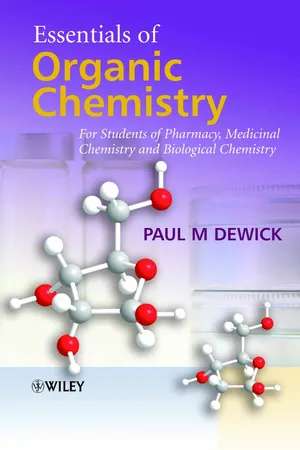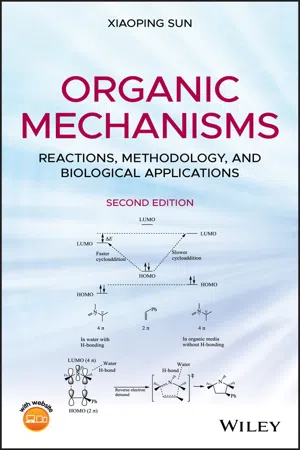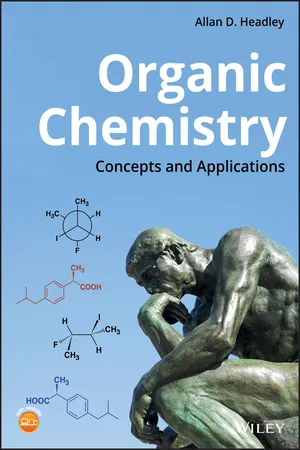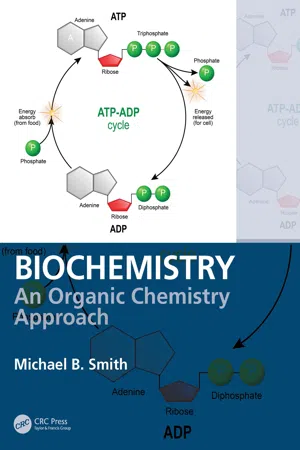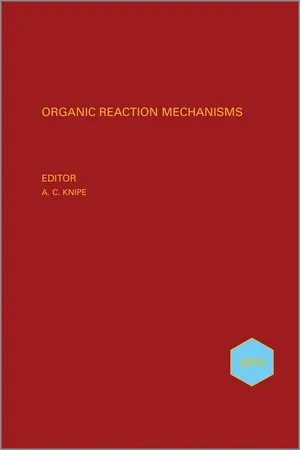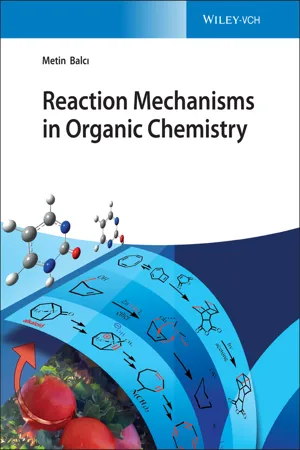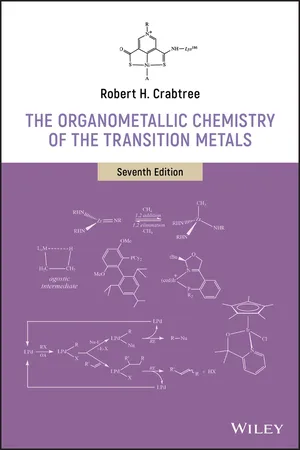Chemistry
Electrophilic Addition
Electrophilic addition is a chemical reaction in which an electrophile (an electron-deficient species) reacts with a nucleophile (an electron-rich species) to form a new molecule. This process commonly occurs in organic chemistry, particularly in the addition of unsaturated compounds like alkenes and alkynes. The electrophile attacks the double or triple bond, leading to the formation of a single bond and a new molecule.
Written by Perlego with AI-assistance
Related key terms
Related key terms
1 of 4
Related key terms
1 of 3
7 Key excerpts on "Electrophilic Addition"
- eBook - ePub
Essentials of Organic Chemistry
For Students of Pharmacy, Medicinal Chemistry and Biological Chemistry
- Paul M. Dewick(Author)
- 2013(Publication Date)
- Wiley(Publisher)
8
Electrophilic reactions
In the preceding chapters we have seen how new bonds may be formed between nucleophilic reagents and various substrates that have electrophilic centres, the latter typically arising as a result of uneven electron distribution in the molecule. The nucleophile was considered to be the reactive species. In this chapter we shall consider reactions in which electrophilic reagents become bonded to substrates that are electron rich, especially those that contain multiple bonds, i.e. alkenes, alkynes, and aromatics. The π electrons in these systems provide regions of high electron density, and electrophilic reactions feature as the principal reactivity in these classes of compounds. We term the reactions electrophilic rather than nucleophilic, since it is the electrophile that provides the reactive species.8.1 Electrophilic Addition to unsaturated carbon
The characteristic reaction of alkenes is Electrophilic Addition, in which the carbon–carbon π bond is replaced by two σ bonds.The π bond of an alkene results from overlapping of p orbitals and provides regions of increased electron density above and below the plane of the molecule. These electrons are less tightly bound than those in the σ bonds, so are more polarizable and can interact with a positively charged electrophilic reagent. This forms the first part of an Electrophilic Addition, in which the electrons are used to form a σ bond with the electrophile and leave the other carbon of the double bond electron deficient, i.e. it becomes a carbocation. This carbocation is then rapidly captured by a nucleophile, which donates its electrons to form the second new σ bond. This latter step is very much faster than the first step, and thus carbocation formation becomes the rate-determining step in this bimolecular - eBook - ePub
Organic Mechanisms
Reactions, Methodology, and Biological Applications
- Xiaoping Sun(Author)
- 2020(Publication Date)
- Wiley(Publisher)
3 FUNCTIONALIZATION OF THE ALKENE C=C BOND BY Electrophilic AdditionSAlkenes are characterized by Electrophilic Addition reactions essentially due to special nucleophilicity associated to the π bond in their C=C double bond domain. The general pattern of the reactions can be written asBy the end, an unsaturated alkene is transformed into a saturated functionalized hydrocarbon. In the course of the reaction, one π bond (C=C) and one σ bond (A–B) are broken, and two new σ bonds (C–A and C–B) are formed. Since the bond dissociation energy (BDE ) of a π bond is in general smaller than a σ bond, the enthalpy (ΔH°) of the overall reaction is negative. At ambient temperature, the addition reactions are thermodynamically favorable as the entropy effect is less significant. Kinetically, the π bond in an alkene C=C domain is vulnerable due to diffusive pπ orbital lobes (electron cloud) distributed above and below the C–C linkage. They make a C=C π bond nucleophilic, readily donating a pair of the π‐electrons to an available electrophilic reagent (an electron‐deficient species readily accepting a pair of electrons). As a result, the aforementioned bond‐breaking and bond‐formation take place fast in relatively mild conditions, leading to an overall addition reaction. In addition, the vulnerable C=C π bond can also be effectively attacked by some radical species giving rise to homolytic cleavage of the π bond. As a result, in the presence of certain radical initiators the alkene additions can follow radical mechanisms.Mechanistically, the alkene addition reactions can be divided into two categories, stepwise reactions (via an intermediate carbocation, radical, or other cationic species) and concerted reactions (via a single transition state). The reactions can also be categorized as syn‐additions (cis‐additions), with two groups (A and B) added to the alkene in the same side of the C=C bond, and anti‐additions (trans - eBook - ePub
Organic Chemistry
Concepts and Applications
- Allan D. Headley(Author)
- 2019(Publication Date)
- Wiley(Publisher)
(8‐4) .(8‐4)Note that since the alkene is unsymmetrical, there are two possible carbocations formed, and as a result, there will be two possible products, as shown in the reactions in Reactions (8‐5) and (8‐6) .(8‐5)(8‐6)Energy profile for the hypothetical Electrophilic Addition reaction.Figure 8.1This type of reaction in which electrophiles (typically along with its counter anion) are added to the carbon–carbon double bond of an alkene is called an Electrophilic Addition reaction. The overall general reaction is shown in Reaction (8‐7) .(8‐7)The two steps of the reaction mechanism shown in Reactions (8‐5) and (8‐6) are called the elementary steps of the reaction mechanism, and these steps are shown in the energy profile diagram given in Figure 8.1 . Note that in the energy profile diagram, the relative energies of the reactants, intermediates, and products are shown for each of the elementary steps and that the intermediates are always shown in the middle of the reaction profile diagram.Energy profile diagrams will be used frequently throughout this course to analyze various types of reactions.8.3 Addition of Hydrogen Halide to Alkenes (Hydrohalogenation of Alkenes)
8.3.1 Addition Reactions to Symmetrical Alkenes
In this section, the knowledge gained in the previous section will be applied to real molecules to not only predict the organic products, but the major organic product. The first reaction that will be examined is the addition of hydrochloric acid (H‐Cl) to cyclohexene as shown in Reaction (8‐8) - eBook - ePub
Biochemistry
An Organic Chemistry Approach
- Michael B. Smith(Author)
- 2020(Publication Date)
- CRC Press(Publisher)
3 Nucleophiles and ElectrophilesAliphatic substitution reactions are early examples of organic chemical reactions in a typical undergraduate organic chemistry course. Such reactions involve the reaction of nucleophilic species with an electrophilic species, and for the most part they follow first-order or second-order kinetics. There are nucleophiles that are prevalent in biochemical reactions, including alcohols, amines, and thiols. Substitution reactions in a typical organic chemistry course involve reactions at carbon that is connected to a heteroatom moiety such as a halogen leaving group. In biochemistry the leaving group is often a phosphonate ester or another biocompatible group. Another type of nucleophilic reaction involves carbonyl compounds, including acyl addition of ketone and aldehyde moieties and acyl substitution reactions of carboxylic acid derivatives.This chapter will briefly review the SN 2 and SN 1 reactions and then describe nucleophiles that are common in biochemical applications and the substitution reactions that are common for these nucleophiles. Nucleophilic reactions require electrophilic species. Electrophiles or electrophilic substrates are common in biochemistry, including phosphonate derivatives, carbonyl compounds and imine compounds. Any discussion of typical nucleophilic reactions also requires an understanding of such electrophilic substrates. The fundamentals of both acyl addition and of acyl substitution reactions will be presented for carbonyl electrophilic centers and the reactions of these electrophilic centers with nucleophiles.3.1 Nucleophiles and Bimolecular Substitution (the SN 2 Reaction)The SN 2 reaction is one of the seminal reactions in a typical undergraduate organic chemistry course. The reaction of 1-bromo-3-methylbutane with sodium iodide (NaI) using acetone as a solvent gave 1-iodo-3-methylbutane, in 66% yield.1 In terms of the structural changes, the iodide ion substitutes for the bromine, producing bromide ion (Br– ). Iodide reacted as a nucleophile in the reaction at Cδ+ of the alkyl bromide, breaking the C—Br bond and transferring the electrons in that bond to bromine. In molecules that contain the C—Br bond, or indeed a C—C bond, where X is a heteroatom-containing group, the carbon will have a δ+ dipole. In other words, the carbon atom is electrophilic, and the substrate that reacts with the nucleophile is called an electrophile. The reaction of a nucleophile with an aliphatic electrophile is formally called nucleophilic aliphatic substitution , illustrated in Figure 3.1 . The displaced atom or group (e.g., chloride), departs (leaves) to become an independent ion. Displacement of chlorine leads to the chloride ion (Cl– ), but the bromide ion, iodide ion, or a sulfonate anion also correlates to X, which is referred to as a leaving group . In many biochemical reactions, the leaving group is a phosphate, —O–PO2 - eBook - ePub
Organic Reaction Mechanisms 2010
An annual survey covering the literature dated January to December 2010
- A. C. Knipe, A. C. Knipe(Authors)
- 2012(Publication Date)
- Wiley(Publisher)
Chapter 11 Addition Reactions: Polar AdditionP. Ko ovskýDepartment of Chemistry, University of Glasgow, Glasgow, UKReviews Electrophilic Additions Halogenation and Related Reactions Additions of ArSX, ArSeX, and Related Reagents with Electrophilic Sulfur Additions of Hydrogen Halides and Other Brønsted Acids Additions of Electrophilic Carbon Additions of Electrophilic Nitrogen Additions Initiated by Metals and Metal Ions as Electrophiles Miscellaneous Electrophilic Additions Nucleophilic AdditionsAdditions to Multiple Bonds Activated by Other Electron-withdrawing Groups Additions of Organometallics to Activated Double Bonds Miscellaneous Nucleophilic Additions ReferencesAdditions to Multiple Bonds Conjugated with C—OReviews
During the coverage period of this chapter, reviews have appeared on the following topics: computational analysis of the reaction mechanisms in terms of reaction phases, including hidden intermediates and hidden transition states;1 cationic polymerization of vinyl monomers in aqueous media, ranging from monofunctional oligomers to long-lived polymer chains;2 Mirozoki–Heck reaction;3 the Heck reaction applied to 1,3- and 1,2-unsaturated derivatives with emphasis on molecular complexity;4 oxidative Heck reaction;5 progress in the Heck and Suzuki reaction catalysed by Pd-N-heterocyclic carbene complexes;6 Brønsted acid versus metal catalysis in hydroamination reactions;7 scope and limitations of the hydroarylation reactions;8 transition-metal-catalysed alkene and alkyne hydroacylation;9 recent advances in carbocupration of α-heterosubstituted alkynes;10 regioselective reductive cross-coupling of unsymmetrical alkynes;11 copper- and rhodium-catalysed enantioselective conjugate addition;12, 13 cyclic carbometallation of alkenes, arenes, alkynes, and allenes;14 intramolecular 1,2- and 1,4-addition reactions;15 conjugate addition reactions of carbon nucleophiles to electron-deficient dienes;16 new development of oxa-Michael reaction;17 progress on the catalytic asymmetric Michael addition reaction;18 cinchona alkaloid-catalysed nucleophilic conjugate addition to electron-deficient C C bonds;19 development of chiral thiourea catalysts and their application to asymmetric catalytic reactions;20 privileged chiral catalysts in asymmetric Morita–Baylis–Hillman (MBH)/aza-MBH reaction;21 chiral, chelating hydroxyalkyl and hydroxyaryl N-heterocyclic carbenes and their application in copper-catalysed asymmetric conjugate addition;22 addition and cycloaddition reactions of phosphinyl- and phosphonyl-2H-azirines, nitrosoalkenes, and azoalkenes;23 inter- and intra-molecular reactions of epoxides and aziridines with π-nucleophiles;24 applications of dynamic nuclear polarization to the study of reactions and reagents in organic and biomolecular chemistry;25 and selectivity in metal-catalysed C C bond cleavage of alkylidenecyclopropanes.26 - eBook - ePub
- Metin Balc?, Metin Balc?, Metin Balc?, Metin Balc?, Metin Balc?(Authors)
- 2021(Publication Date)
- Wiley-VCH(Publisher)
4 Addition Reactions to AlkenesAn addition reaction is a chemical reaction in which two or more compounds come together to form a larger compound. However, only chemical compounds containing multiple bonds such as C=C (or C=O) double bonds or C≡C triple bonds can undergo an addition reaction. Two new σ-bonds are formed during this reaction, and a double or triple bond is usually broken to form the required single bonds. A double bond consists of a σ-bond and a π-bond. A σ-bond is more stable than a π-bond because in the former, the bonding takes place in the direction of the axis connecting the two atoms, while in the latter, the p orbitals interfere above and below the plane that forms a double bond. Therefore, this interference is not as effective as in σ-bonds. Thus, π-bonds are less stable, and the most common reactions of double bonds transform π-bonds into σ-bonds. A general addition reaction to a C=C double bond is given below.We can classify addition reactions in two groups according to the polarity of the reactions:Polar addition reactions, namely:Electrophilic Addition reactions Nucleophilic addition reactionsNonpolar addition reactions, namely:Free radical addition reactions Cycloadditions reactions In this chapter, we will discuss Electrophilic Addition reactions to C=C double bonds and C≡C triple bonds.The electron density between two carbon atoms of a double bond is high. Therefore, alkenes show nucleophilic properties and act as nucleophiles in addition reactions. Because of this feature of alkenes, compounds with an electron deficiency, i.e. electrophiles, can be readily attacked by double-bond electrons. In this section, we will focus mainly on the reaction of alkenes with electrophiles. The question arises here, Can alkenes react with nucleophiles? For alkenes to react with nucleophiles, it is essential to decrease the electron density in the double bond. How is this achieved? - Robert H. Crabtree(Author)
- 2019(Publication Date)
- Wiley(Publisher)
* back donation, and so the polyene is left with a net positive charge, favorable for nucleophilic attack.Encouraging nucleophilic abstraction by starting from a high‐oxidation‐state metal is shown in Eq. (8.29 ) (tripod = HC(C5 H5 N)3 ). The acetate abstracts the alkyl from the metal, the two electrons in the M-C bond reducing the metal from rare Ni(IV) to the much stabler Ni(II) state[16 ]:8.298.5 Electrophilic Addition and Abstraction
In common with 2e nucleophiles, zero‐electron electrophiles such as H+ or Me+ can attack a ligand. Unlike nucleophiles, however, they can also attack the M-L bond or the metal itself because, as 0e reagents, they do not alter the electron count of the complex (Section 2.3 ). The resulting mechanistic complexity and unreliable selectivity makes electrophilic attack far less controllable and less useful than nucleophilic attack. Polysubstitution is also more common in the electrophilic case [17 ].Addition to the Metal
This happens during OA by the SN 2 or ionic mechanisms where initial Electrophilic Addition to the metal (Eq. (8.30 ) and Sections 6.3 and 6.5 ) is followed by substitution:8.308.31Without the second step, the reaction becomes a pure Electrophilic Addition. For example, the highly nucleophilic Co(I) anion, [Co(dmg)2 py]− reacts with an alkyl triflate with inversion at carbon (Eq. (8.31 )).The addition of any zero‐electron ligand to the metal is also an Electrophilic Addition: AlMe3 , BF3 , HgCl2 , Cu+ , and even CO2 , when it binds η1 via carbon, all act in this way. Each of these reagents has an empty orbital by which it can accept a dπ electron pair from the metal.Addition to a Metal–Ligand Bond
Protonation at L is common – for example, protonation of LnM–H can give a dihydrogen complex[18 ] [LnM–(H2 )]+ . Early metal alkyls such as Cp2 TiMe2
Index pages curate the most relevant extracts from our library of academic textbooks. They’ve been created using an in-house natural language model (NLM), each adding context and meaning to key research topics.
Explore more topic indexes
Explore more topic indexes
1 of 6
Explore more topic indexes
1 of 4
